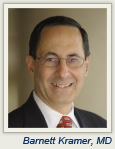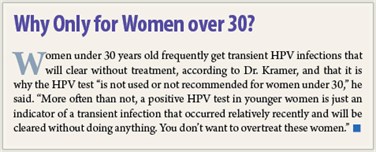Results of a large-scale cervical cancer screening study using concurrent human papillomavirus (HPV) and Pap testing should “reassure” women over 30 who test negative for HPV and have normal Pap tests that “it is extremely safe to go 3 years” before being tested again, Barnett S. Kramer, MD, MPH, said in an interview with The ASCO Post. Dr. Kramer is Editor-in-Chief of the Journal of the National Cancer Institute and the screening and prevention editorial board of Physician Data Query (PDQ), and recently retired as Associate Director for Disease Prevention at the National Institutes of Health.
 Initiated by the NCI, the screening investigation was called a “real world” study because it was done in a community setting among 33,818 women receiving concurrent HPV and Pap testing at Kaiser Permanente Northern California. Investigators estimated 5-year cumulative evidence of cervical cancer and cervical intraepithelial neoplasia grade 3. Among their conclusions was that concurrent testing allowed screening intervals to be safely extended to 3 years for women who had negative HPV tests and normal Pap smears and “reduced the burden of screening on women and clinicians.” Details of the study were reported at the recent ASCO Annual Meeting1 and in the June 15 edition of The ASCO Post.2
Initiated by the NCI, the screening investigation was called a “real world” study because it was done in a community setting among 33,818 women receiving concurrent HPV and Pap testing at Kaiser Permanente Northern California. Investigators estimated 5-year cumulative evidence of cervical cancer and cervical intraepithelial neoplasia grade 3. Among their conclusions was that concurrent testing allowed screening intervals to be safely extended to 3 years for women who had negative HPV tests and normal Pap smears and “reduced the burden of screening on women and clinicians.” Details of the study were reported at the recent ASCO Annual Meeting1 and in the June 15 edition of The ASCO Post.2
“Initial studies of any diagnostic or screening tests often take place in more controlled settings, where you optimize the performance and so they tell you whether the screening test could work,” Dr. Kramer commented. “I think [the NCI study findings are] a good indicator that in the real world, you don’t need to do an HPV and a Pap test every year. There probably would be no additional benefit, but there could be additional harm resulting from unnecessary biopsies, unnecessary investigation.”
Overcoming Reluctance
The study validates current cervical cancer screening recommendations from several groups, including the American Congress of Obstetricians and Gynecologists. Reported reluctance to adopt these guidelines and abandon routine annual testing can be attributed to a combination of factors.
“There is an established American medical culture, and if a new test comes along, it often simply gets added to whatever is being done at that time. Physicians who rely on a routine schedule may be reluctant to change it,” Dr. Kramer said. He added that the “very strong evidence” from the study about concurrent testing being safe and effective for women with a negative HPV test and a normal Pap smear, “undercuts the strategy to do it every year no matter what.”
 In addition, “for most of their adult lives, women are used to getting the test every year, and so they don’t question continuing to get it every year, even though new information becomes available that shows it is quite safe and may even be safer to add a test, but space out the testing. You often hear that if you change it to every 3 years instead of every 1 year, women will be less inclined to get it. I don’t know of any evidence to substantiate that,” Dr. Kramer said.
In addition, “for most of their adult lives, women are used to getting the test every year, and so they don’t question continuing to get it every year, even though new information becomes available that shows it is quite safe and may even be safer to add a test, but space out the testing. You often hear that if you change it to every 3 years instead of every 1 year, women will be less inclined to get it. I don’t know of any evidence to substantiate that,” Dr. Kramer said.
The study also concluded, “In routine clinical practice, a single HPV test was clearly superior to a single Pap smear in women age 30 and above for predicting who would develop [cervical intraepithelial neoplasia grade 3] or cervical cancer within 5 years.” Dr. Kramer noted that while the HPV test is more sensitive than a Pap smear, a Pap smear is more specific, and that is why it adds import to a positive HPV finding. “The risk of developing [cervical intraepithelial neoplasia grade 3], higher-grade lesions, or cancer was elevated considerably in women who were HPV-positive. But the risk was highest if they were not only HPV-positive, but also Pap smear–positive.”
Current and Future Testing
As previously reported in The ASCO Post,2 “Based on their findings, the authors suggest that a screening program with a single HPV test could be used first, and if negative, no additional testing would be needed for at least 3 years; the Pap test would be reserved only for women who were HPV-positive.” They cautioned, however, that this hypothesis still needs to be tested.
“Although it may someday be shown that it’s perfectly legitimate to use HPV as the primary and the Pap test as the triage,” Dr. Kramer said, “we’re not there yet; it would take more information. But it is conceivable that if you have an HPV as the primary test and it is negative, then you can be confident that the risk will be very low over the next 3 years, so you can stop there. If it is positive, then you can do a Pap test to see if treatment is needed right then and there. Or if the Pap is negative, you could wait 1 year and see if the HPV infection clears, because many HPV infections will clear.”
Dr. Kramer noted that currently, HPV testing has only been approved by the FDA in two circumstances. One approved use, which was not tested in this study, is “if a woman has minor abnormalities on the Pap smear, you can triage her to either be treated or to observation with an HPV test. If the HPV test is positive, then you would go on to treatment or colposcopy. If it is negative, then it is safe to follow her and see if the abnormality clears,” Dr. Kramer explained.
“The only other approved use is the concurrent use of both HPV and a Pap test, which was the design of this study, which reaffirms that in the community setting, that is a perfectly safe, legitimate strategy,” he said. “It works wells, and it shows how good HPV is as a primary screen when combined with Pap smears.”
While the study concluded that concurrent screening at 3-year intervals “reduced the burden of screening on women and clinicians,” Dr. Kramer pointed out, “you could also decrease the burden considerably if ultimately you showed that you can use HPV as the primary and the Pap test as the triage.” Self-collection of an HPV sample by women who didn’t need a Pap test would ultimately “be the most convenient, if it were proven to be just as safe,” he added. While there would need to be safeguards to ensure that samples were collected and submitted properly, there is precedence in the community setting for patients collecting screening samples—for example, stool samples for colon cancer screening—and then mailing or bringing the samples to a medical center. ■
Disclosure: Dr. Kramer reported no potential conflicts of interest.
References
1. Katki HA, Kinney WK, Fetterman B, et al: Cervical cancer risk for 330,000 women undergoing concurrent HPV testing and cervical cytology in routine clinical practice. 2011 ASCO Annual Meeting. Abstract 1508. Presented June 6, 2011.
2. Goodman A: 3-year screening interval safe for women with HPV-negative and normal Pap tests, data show. The ASCO Post, June 15, 2011.

